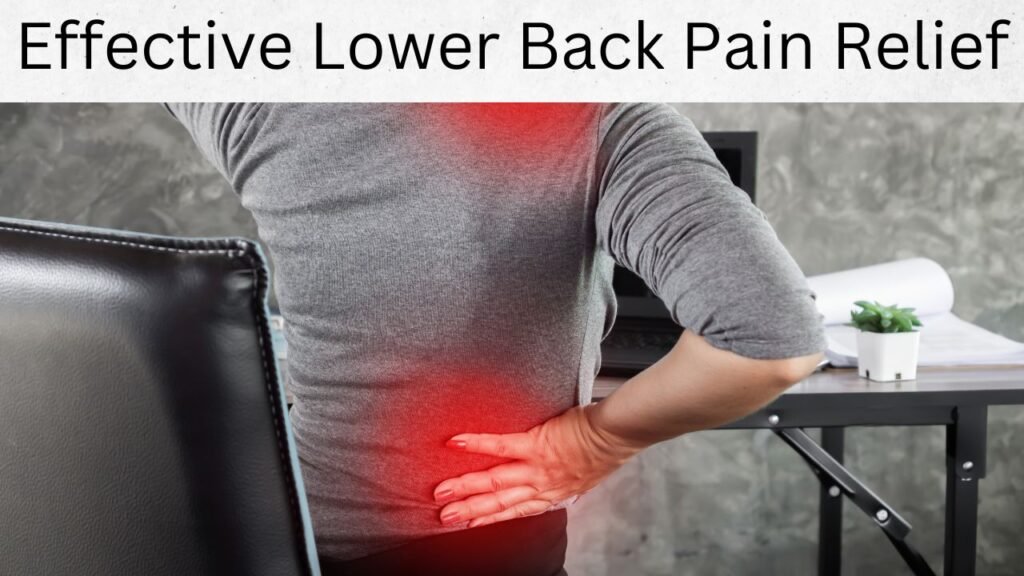Lower back pain affects millions of people worldwide. Whether caused by poor posture, injury, or muscle strain, it can interfere with daily life. Fortunately, effective treatments and exercises can help reduce pain and improve mobility. Understanding the right approach can make a significant difference in recovery and prevention.

Causes of Lower Back Pain
Before diving into treatments, it’s important to understand the common causes:
- Poor posture: Sitting for long hours with incorrect posture strains the lower back muscles.
- Muscle strain: Overuse or sudden movements can lead to tightness and discomfort.
- Herniated discs: When spinal discs bulge or rupture, they press on nearby nerves, causing pain.
- Sciatica: Compression of the sciatic nerve leads to pain that radiates down the legs.
- Degenerative disc disease: Age-related wear and tear on spinal discs results in stiffness and discomfort.
- Sedentary lifestyle: Lack of movement weakens core muscles, reducing spinal support.
Addressing the root cause helps in selecting the right treatment and exercises for relief.
Effective Exercises for Lower Back Pain Relief
Exercise plays a key role in strengthening muscles and reducing pain. Here are some of the most effective movements:
1. Cat-Cow Stretch
This gentle movement increases flexibility and relieves tension in the lower back.
How to do it:
- Start on all fours with your hands under your shoulders and knees under your hips.
- Inhale, arch your back, and look up (cow pose).
- Exhale, round your back, and tuck your chin (cat pose).
- Repeat for 10 repetitions.
2. Knee-to-Chest Stretch
This stretch helps relax the lower back and improve spinal alignment.
How to do it:
- Lie on your back with your knees bent and feet flat on the floor.
- Pull one knee toward your chest while keeping the other foot on the ground.
- Hold for 20-30 seconds, then switch legs.
- Repeat 2-3 times on each side.
3. Pelvic Tilts
Pelvic tilts strengthen core muscles, supporting the lower back.
How to do it:
- Lie on your back with knees bent and feet flat on the floor.
- Tighten your abdominal muscles and press your lower back into the floor.
- Hold for a few seconds, then relax.
- Perform 10-15 repetitions.
4. Bird-Dog Exercise
This movement enhances core stability and improves spinal alignment.
How to do it:
- Start on all fours.
- Extend one arm forward while lifting the opposite leg behind you.
- Hold for a few seconds, then return to the starting position.
- Switch sides and repeat 10 times per side.
5. Bridge Exercise
Bridges strengthen the glutes and core muscles, reducing strain on the lower back.
How to do it:
- Lie on your back with knees bent and feet hip-width apart.
- Lift your hips off the ground while keeping your shoulders on the floor.
- Hold for a few seconds, then lower back down.
- Perform 10-15 repetitions.
6. Seated Spinal Twist
This exercise improves flexibility and relieves spinal tension.
How to do it:
- Sit on the floor with your legs extended.
- Bend one knee and place the foot outside the opposite thigh.
- Twist your torso toward the bent knee, placing one hand on the floor behind you.
- Hold for 20-30 seconds, then switch sides.
7. Child’s Pose Alternative (Modified Cobra Stretch)
Since Child’s Pose may not suit everyone, this stretch is a great alternative.
How to do it:
- Lie on your stomach with hands under your shoulders.
- Gently press up, keeping your hips on the floor.
- Hold for 15-30 seconds, then return to the starting position.
- Repeat 5 times.
Additional Treatments for Lower Back Pain Relief
Besides exercise, other treatments can help reduce pain and support recovery.
1. Heat and Cold Therapy
Applying heat helps relax tense muscles, while cold therapy reduces inflammation.
- Use a heating pad or warm compress for 15-20 minutes.
- Apply an ice pack wrapped in a towel for 10-15 minutes.
2. Massage Therapy
A professional massage can improve blood flow, relieve muscle tightness, and reduce stiffness. Regular massages promote relaxation and prevent recurring pain.
3. Chiropractic Adjustments
Chiropractors perform spinal adjustments to restore proper alignment and relieve nerve pressure. Many people experience significant pain relief after chiropractic care.
4. Acupuncture
This ancient practice involves inserting thin needles into specific points on the body. It helps stimulate natural pain relief mechanisms and improves circulation.
5. Proper Posture Awareness
Maintaining good posture reduces unnecessary strain on the spine.
- Sit with your back straight and shoulders relaxed.
- Adjust your workstation to keep your screen at eye level.
- Avoid slouching while using a phone or computer.
6. Supportive Footwear
Wearing the right shoes reduces spinal stress and supports better posture. Choose footwear with proper arch support and cushioning.
7. Hydration and Nutrition
Drinking enough water keeps spinal discs hydrated. A diet rich in calcium, magnesium, and vitamin D supports bone and joint health.
When to See a Doctor
While mild back pain often improves with exercise and self-care, some cases require medical attention. Seek a doctor if:
- Pain persists for more than a few weeks.
- Pain radiates down the legs.
- You experience numbness or weakness.
- Pain worsens despite treatment.
- You have difficulty walking or controlling bladder function.
Final Thoughts
Lower back pain relief requires a combination of targeted exercises, proper posture, and supportive treatments. Strengthening core muscles, staying active, and using pain management techniques can help prevent future discomfort. If pain persists, consult a healthcare professional to find the best treatment plan for your needs.